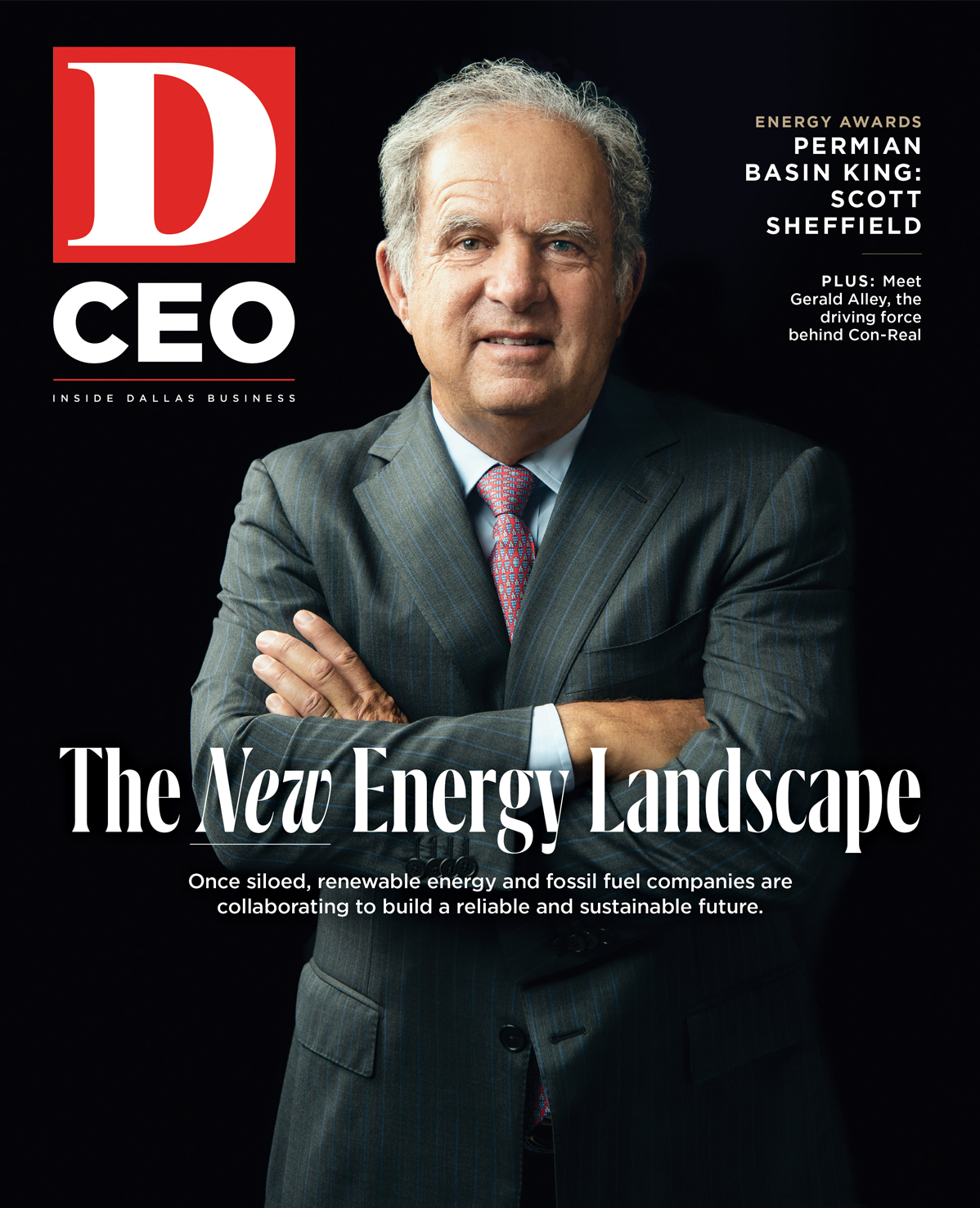It’s hard to overstate the impact the oil and gas industry has had on North Texas. Beyond global companies and game-changing innovations, it has created scores of millionaires—and a few billionaires—who have helped fund the region’s growth and arts and education infrastructure.
From the black gold of the gusher age to the natural gas boom and fracking in the Barnett Shale, the industry has seen big shifts during the last century or so. And now, another big evolution is underway: a movement away from strict reliance on fossil-based forms of energy and consumption to include renewable sources such as solar and wind.
What we’re seeing is a sector fueled by interdisciplinary camaraderie and disruptive innovation. In recognition of this shift, D CEO revamped its former Oil & Gas Awards to include renewables in our new Energy Awards. In this special report, read about some of the key players leading the way—and a profile of Legacy Award winner Scott Sheffield of Pioneer Natural Resources by industry journalist Jennifer Warren.
The Next Energy Mavericks
A different breed of risk-takers and innovators are propelling the sector into a new era. One thing is clear: This ain’t your daddy’s energy industry.
Wall Street and consumers are demanding that companies across the country own up to their impact by providing environmental, social, and governance transparency. Closer to home, winter storm Uri in February 2021 revealed surprising weaknesses in Texas’ energy grid, spotlighting the need for new and more reliable sources.
In response, fossil fuel players are stepping up to create the energy sector of the future—an industry marked by interdisciplinary camaraderie and disruptive innovation. North Texas’ leading role in the shift is underscored by the seven finalists in the Excellence in Innovation and Sustainability category in D CEO’s 2021 Energy Awards.
Highlighted in this feature, they’re focusing on everything from bacteria microbes and hemp crops to carbon capture and clean backup power generation.
A New Spin on Recycling
Engineer Mark Bouldin moved to the United States from Hamburg in 1988, beginning a more than 30-year career in the energy sector centered around lubricants and asphalt and winding through major players, including Shell, Sunoco, and Koch Industries.
At Safety Kleen, Bouldin led the largest collector and re-refiner of used motor oil as president of performance products. He then built liquid waste collection company GFL Environmental’s U.S. operations through acquisitions, eventually taking the company public.
This past March, Bouldin took his expertise in the recycled motor oil niche to TopSail Energy as CEO. “I saw a nice opportunity to see how we could build something that was unique for Texas,” says Bouldin, who has since rebranded the company to Blue Tide Environmental.
“We don’t see ourselves as an energy company. We see ourselves as a recycler,” he says.
He also revamped a marine fuel refinery in the Cedar Bayou to work with used motor oil and created a vision of becoming the first major re-refinery in Texas to process used motor oil and turn it into high-quality engine oil.
“Our goal was to see if we could even further reduce the carbon intensity of what we were doing with this recycling,” Bouldin says.
When refinery construction is complete in Cedar Bayou, Blue Tide will purchase used motor oil from collection trucks, refine it, then sell it to distributors as a base for engine oil. When the plant is fully up and running, it will move 4,000 barrels per day—roughly 168,000 gallons. Within three years, Bouldin hopes to expand to the East Coast, and North Texas will play a big role in his company’s future.
“Dallas is right now, probably the No. 1 or No. 2 generator of used motor oil in the state, and will likely become the No. 1 generator,” Bouldin says.
Embracing Carbon Capture
In 2013, after nine years in the oil and gas industry, former attorney Jonathan Grammer began toying with carbon capture when a client approached him about using captured CO2 for tertiary recovery in a Texas Panhandle reservoir. Grammer spent two years amassing knowledge and data before oil prices dropped, and the project was shelved.
“But the science was all there,” Grammer says.
After winter storm Uri hit Texas in February 2021, legislative priorities shifted from harnessing clean energy to ensuring reliable power. Grammer knew the sector needed a way to make coal and natural gas viable—which meant capturing CO2.
“I knew carbon capture was going to be the next big thing,” he says.
We can’t just put coal and oil and natural gas and fossil fuels up on the chopping block and make them the scapegoat.
Jonathan Grammer, U.S. Carbon Capture Solutions
By the spring of 2021, Grammer had pulled together a team of five experts in oil and gas, law, technology, and reservoir engineering to form U.S. Carbon Capture Solutions, a consulting firm that works with emitters to capture CO2 and pipe it to oil reservoirs for tertiary recovery.
Where leaders such as Denbury Resources and Kinder Morgan had harnessed naturally occurring CO2 for enhanced oil recovery, Grammer is pivoting the process to industrial CO2.
“Previously, it was too expensive,” he says. “We now have incredible investment credits and tax credits that have changed the financial landscape.”
These credits have compelled some of Grammer’s clients from his original research to change their position, and new players to jump on board.
With costs becoming less of a barrier, Grammer aims to use amine solvents to scrub the low-purity industrial CO2 produced by emitters such as power plants.
“In some instances, there’s almost going to be a CO2 impact process,” he says, “where we’re going to have to not only strip out the carbon dioxide, but almost re-enrich it—increase the purity level—before we can pipe it into a transmission pipeline.”
He hopes to have shovel-ready projects in the panhandle and the Midwest next year.
“We’re looking at four to five million metric tons of carbon dioxide probably in mid-2022 that we’re assisting with capturing,” he says.
The biggest challenge? Education.
“This is not just a myth or a theory; we can actually do this: You can actually keep using coal and natural gas as a fuel source, and you can bring down that climate change number,” Grammer says.
A 4-Billion-Year-Old Solution
Bill Lantz began his career as a mud engineer before joining his father’s small company, which applied naturally occurring microbes in several settings, including oil fields. When his dad passed away, Lantz formed Prosper-based JGL Solutions, focusing largely on using microbe bacteria in the energy sector as an alternative to chemical scale and corrosion inhibitors, emulsifiers, and biocides. It’s an ancient solution; research indicates that microbial organisms have been around for more than 3.7 billion years.
“Wherever the microbes are applied, even if you spill them accidentally, they do good for the environment, not harm— the complete opposite of chemicals,” Lantz says.
He assesses chemical levels in wells, waterfloods, and salt-water disposal systems, clearing out caustic compounds. Then, his team injects naturally occurring microbe bacteria into the system, creating unique colonies for each site.
“We blend [microbe strands] together, depending on what the situation calls for,” Lantz says.

Because microbes reproduce on their own, no pumps or drums are needed to control concentration, so maintenance costs are lower, and the risk of chemical leaks is eliminated. JGL is set to open a lab in DFW soon, hoping to reach new companies fracking near the Barnett Shale.
“It’s just big companies getting past this fear of trying [microbes] in a frac,” Lantz says.
He is also branching into soil remediation, using microbes to clean up chemical and oil spills in lieu of compounds such as hydrogen peroxide.
“We find that we are way better than anything else [oil companies] do speed-wise,” says Lantz, adding that, unlike chemicals, microbes will continue to clean soil until contaminants are completely gone—well beyond state-required levels.
He recently launched a soil remediation pilot program with a major oil industry player in West Texas and hopes that the program’s five sites will provide exposure and credibility, an effort Lantz also undertakes through his company podcast.
“It’s just another way to educate people, and that’s what needs to happen,” Lantz says.
Staying on The Cutting Edge
Matt Vining launched Navigator Solutions in 2012 as a midstream crude oil pipeline in West Texas. He sold the company in 2017 and acquired another crude oil pipeline business; then, in 2021, he formed a carbon capture company, Navigator CO2 Ventures.
“When we look at how is this industry going to evolve and where we want to be when it does, it is with the objective of staying at the cutting edge,” Vining says of his latest venture, which focuses on sequestering high-purity carbon dioxide gas.
Vining plans to build an industrial carbon capture pipeline system spanning 1,200 miles across five Midwestern states. The system will capture CO2 emitted from 20 to 30 ethanol and fertilizer plants, pressurize the gas into a gel, and pipe it to the Mount Simon sandstone formation in northern Illinois, where it will be injected into the ground to reduce emissions. Initially, Vining says the system will move 10 million metric tons of CO2 per year.
“From a domestic perspective, this will be the largest system like this,” Vining says.
Construction will begin in 2023, and the pipeline is estimated to be up and running by 2025. Vining is currently in talks with several parties looking at ways to use pure CO2 as a refrigerant or coolant, such as data center companies, meat processing plants, and bottling plants.
“It’s going to take us a few years to refine out like how wide that spectrum of opportunities really is,” Vining says. “This is the first time in history when it’s been readily accessible at the scale that would be necessary to be relevant.”
A Sustainable Supply Chain
Pony Oil CEO John Paul Merritt did a lot of soul-searching after hitting it big in the oil and gas industry at a young age.
“I’m always trying to figure out ‘What’s my why?’” he says.
Seeing parallels between energy and an emerging hemp commodity, he leveraged his team’s expertise in oil and gas to build a business centered around opportunities in hemp. When he learned of a company that was using Big Ag equipment and practices from corn and cotton farming for hemp crops—which are usually picked by hand—he bought it.
He has since focused that company, Delta Agriculture, on building a sustainable supply chain using hemp grain and fiber as paper, plastic, and soy replacements in consumer products and animal feed. The business is now growing and processing 10,000 acres of hemp at farms and facilities in Colorado, Kentucky, and West Texas.
Merritt is in talks with a pet food maker to use hemp as a soy alternative in the company’s products.
“The nutritional components of [hemp] currently exceed any ingredient they have,” Merritt says.
He says Fortune 500 companies are warming up to a crop that was legalized in 2018 and has only recently become an option when building sustainable supply chains.
“It’s a fairly new crop, but it’s a miracle crop,” he says.
Delta Agriculture also supplies 70 percent of biomass needed for every CBD product on the market and aspires to become a big player in the bioplastics market—a niche that is estimated to make up 40 percent of the overall plastics market by 2040.
But perhaps the area that most excites Merritt is what hemp plants do before harvest.
“Most people don’t know that our crops sequester about 10 tons of CO2 out of the air per acre,” he says.
Merritt is building a CO2 sequestration coalition, leveraging his connections in the oil and gas sector—as well as Fortune 500 businesses in other industries. Together, they aim to plant the largest CO2 sequestration project in the nation in West Texas, enabling a million acres of hemp growth by 2026.
“It’s going to create thousands of jobs that are not affected by the commodity swings of oil and gas politics,” Merritt says.
He says he has met with Gov. Greg Abbott twice in the hope of making West Texas the epicenter of the hemp industry and to fuel the coalition and sequestration project.
“We’re already almost there on a per-acre basis, but here in the next year or two, there will be more acres of hemp grown in West Texas than anywhere else in the world,” he says.
Cleaner Back-Up Generation
When Erich Sanchak was recruited to join Austin-based data center company Digital Realty in 2004, he knew sustainability was a big priority for founder and CEO William Stein.
For each of the company’s 291 data centers worldwide, including 22 in North Texas, Digital Realty works to ensure cooling is efficient—eliminating water use in new facilities and directing outside cool air more immediately toward machines. The company also uses renewable energy to power centers wherever possible. “We are not trying to restrict our vision on any of this,” Sanchack says.
Last year, Digital Realty signed a 7.5-year renewable energy credit agreement with Citi to provide 30 percent of the power needed to run its Dallas facilities through renewable energy. Now, the company is striving to continue to improve efficiency in cooling, power usage, and back-up power supply.
“We are working with our supply chain on how to, on a global scale, develop something that’s either using natural gas, or a fuel cell, or those type of activities, to give a cleaner back-up generation,” Sanchack says.
He is also in the process of moving his sustainability, supply chain, and cybersecurity teams to Dallas—roughly 200 employees.
“Our environmental stewardship group is going to be highly concentrated here,” he says.
A Transparency Transformation
Scott Rolseth joined oil and gas giant Hunt Energy at the start of the millennium. In 2004, he helped pioneer its liquid natural gas pipeline in South America, cooling natural gas into a liquid and shipping it to markets in Europe, Asia, and Mexico to use in heating, cooking, transportation, and more.
“About 700 million cubic feet a day are sold there,” Rolseth says.
In 2005, he began leading the company’s sustainability efforts; 14 years later, he was named vice president of facilities, engineering, sustainability, and supply chain.
In the next year or two, there will be more acres of hemp grown in West Texas than anywhere else in the world.
John Paul Merritt, Delta Agriculture
Being private has long given Hunt flexibility to focus on environmental concerns that the pressures of shareholders often force public entities to forego.
The Dallas-based company was the first to implement International Finance Corp.’s performance standards and still approaches each project with a unique plan to understand and protect an area’s native society, history, and species.
It has modified past pipeline development and construction to accommodate archaeological research, documented ethnobotany in Arctic Canada, and used satellite technology to track no-contact indigenous tribes, so as not to disturb their protected existence.
Rolseth’s team also partners with the National Geographic Society and the Smithsonian Institute to prioritize biodiversity, protection, and conservation around Hunt’s Peruvian projects.
“We’ve even found rare species that were never before known,” he says.
Now, Rolseth’s team is leading the private company through a massive transformation toward transparency—even though it is not bound by shareholder or Wall Street demands.
Hunt published its first ESG report in September and has been inventorying its CO2 assets, reducing its carbon footprint, improving efficiencies, and more.
“We’re also looking at creating zero-emission facilities—modular facilities that reduce not just carbon footprint, but the physical footprint, and can be reused and redeployed in a lot more efficient manner,” Rolseth says.
Additionally, the company has, where possible, opted out of gas flaring, a process in which unwanted byproduct gas is combusted in the open air.
“Anything that is venting naturally, we will tie in and seal,” Rolseth says.
Hunt then sells the captured natural gas to gas-gathering companies, even if it is at a net loss. Hunt has even begun diversifying its portfolio, hoping to shift to become an energy provider rather than an oil company.
“We’re not just an oil company anymore,” Rolseth says. “We’re shifting into cleaner fuels, recognizing that the energy matrix is changing and that it’s not necessarily up to us to decide who wants energy and from what source—it’s up to the consumer.”
2021 Energy Award Winners and Finalists
Legacy Award
Scott Sheffield, Pioneer Natural Resources
Midstream Executives of the Year
Tom Long and Mackie McCrea, Energy Transfer (W)
J. Patrick Barley, Silver Creek Midstream (F)
Alaina Brooks, EnLink Midstream (F)
Upstream Executive of the Year
Jordan Jayson, U.S. Energy Development Corp. (W)
Chris Carter, NGP Energy Capital (F)
Travis Stice, Diamondback Energy (F)
Chad Willis, Istick Capital Management (F)
Renewable Energy Executive of the Year
John Billingsley Jr., Tri Global Energy (W)
Jason Allen, Leeward Renewable Energy (F)
Melissa Miller, Able Grid Energy Solutions (F)
Clark Smith, Buckeye Partners (F)
Excellence in Innovation and Sustainability
Hunt Oil Co., represented by Scott Rolseth (W)
Mark Bouldin, Blue Tide Environmental (F)
Jonathan Grammer, U.S. Carbon Capture Solutions (F)
Bill Lantz, JGL Solutions (F)
John Paul Merritt, Delta Agriculture (F)
Erich Sanchack, Digital Realty (F)
Matt Vining, Navigator CO2 Ventures (F)
Energy Services and Technology Executive of the Year
Joseph DeWoody, Valor Mineral Management (W)
Le’Ann Callihan, NAPE Expo (F)
Joe McKie, Alamo Pressure Pumping (F)
Energy Finance Leader of the Year
Matt Attaway, Align Midstream Partners (W)
Kyle Miller, Silver Hill Energy Partners (F)
Financing Capital Deal of the Year
Tailwater Capital acquires NorTex Midstream Partners (W)
Hunt Perovskite Technologies merges with 1366 Technologies (F)
Metamaterial merges with Torchlight Energy Resources (F)
Pioneer Natural Resources acquires DoublePoint Energy (F)
Private Equity Firm of the Year
Pearl Energy Investments, led by Billy Quinn (W)
Tailwater Capital, led by Jason Downie and Edward Herring (F)
Rising Star/ Future Leader Award
Will McDonald, TenOaks Energy Advisors (W)
Drew Winston, Tailwater Capital (F)
Get the D CEO Newsletter
Author








